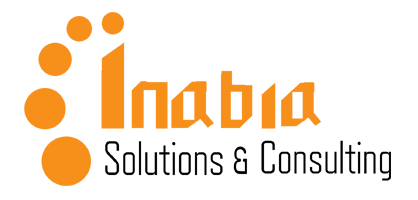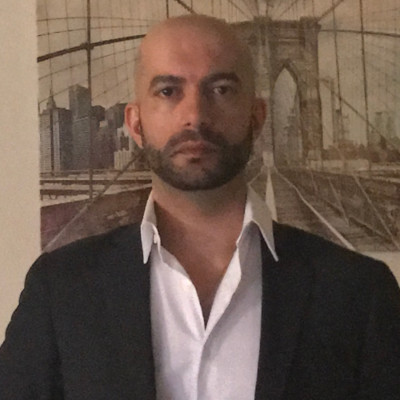OKRs Brainstorming Canvas
- August 27, 2020
- Posted by: Yousef Ghandour
- Category: Business Tips, Corporate

OKRs Brainstorming Canvas: How to structure measurable and actionable goals
Background
OKR (Objectives and Key Results) is a goal setting system used by Intel, Google, and others. It is a simple framework that creates alignment and engagement around measurable goals. OKRs could be used by small teams at a startup to make sure they are stretching while making progress, and also by a big organization such as Google to make sure everyone is moving in the same direction to achieve the company goals. OKRs could also be used at a personal level for personal goals.
OKRs can if defined properly, connect departments and teams, upward, downward and sideways. One OKR can contribute to another KR in a different department, or two levels up in the organization hierarchy. That kind of flexibility in the OKRs structure makes it a good framework to structure departments’ goals, and even company initiatives (strategy).
Most of the people I worked with struggled with how to structure their OKRs. Some companies and teams gave up on OKRs because it didn’t deliver on the OKRs promises to create better alignment, autonomy, and better execution (achieving more)
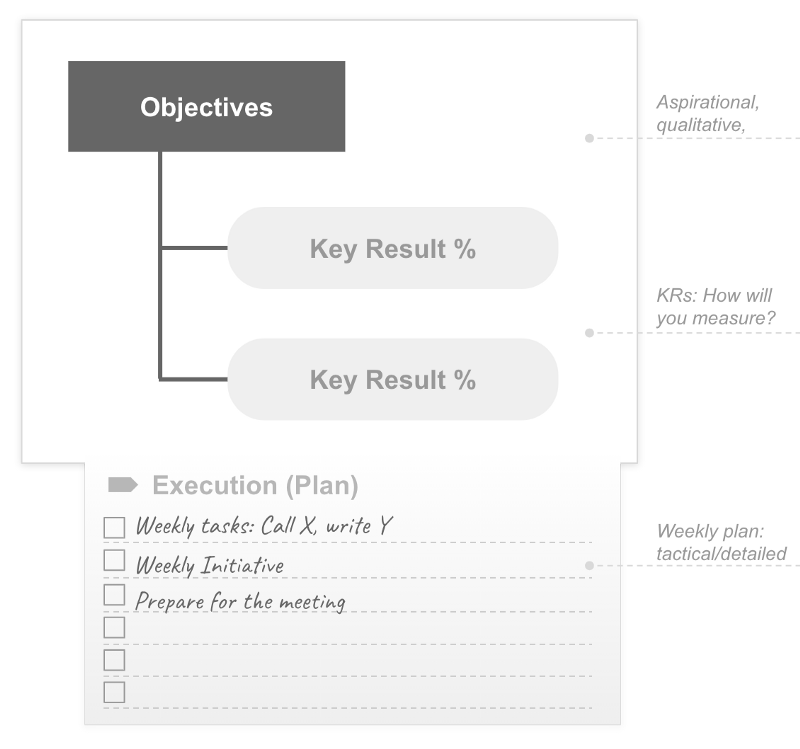
OKRs Cycle
OKRs cycle is a block of time dedicated to complete a set of goals. It started as a shift from the long term annual goal setting to a shorter period of time where you can inspect your progress, review execution, read the market, adjust and do it again. Doing this every quarter lets you inspect at least 4 times a year instead of only once. This also improves urgency, focus, and execution.
Deciding on the length of the cycle depends on your team, company, state and a lot of other factors. Startups or small teams might choose to set OKRs every month to inspect and validate the assumption faster.
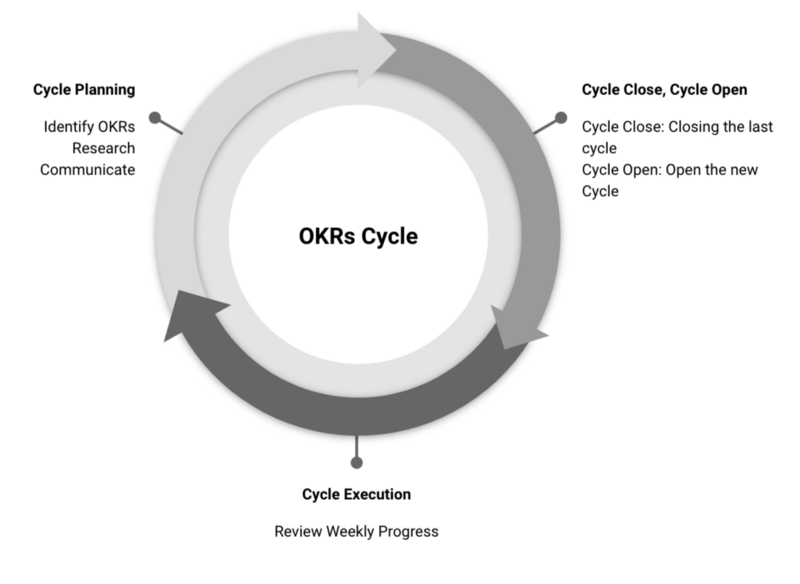
Cycle Planning
Cycle Planning is the process of constructing your OKRs for the next cycle and get an alignment. Some teams take a week to do that, while others take as long as the whole cycle to prepare for the next one. This depends on the level of predictability you need and how much autonomy your team has. Outcomes of this phase: OKRs are 90% ready for the next cycle.
You will use the OKRs Brainstorming Canvas the most during this phase.
Cycle Close, Cycle Open
This is the name I use for the kick-off meeting for the cycle (quarter). In my case at the time of writing this post, I lead this offsite with our leadership team including the CEO, VPs and the department’s heads.
Cycle Close
This is basically closing the cycle, which includes but not limited to:
- Update OKRs % complete (for simplicity, I calculate the average of the objective’s KRs % complete
- Grading your execution (OKRs). This is different than the % complete, see the Grading and Self-assessment section for more information. Grading includes self-assessment
- Discuss results with the leadership team
- Review progress toward long term OKRs (strategic OKRs)
Cycle Open
- Align on the OKRs for the next cycle
- Discuss the plan and assess risks
- Discuss VofC. I use VofC to help people stretch. I normally shoot for 7/10 VofC
Cycle Execution
This is the process of helping to effectively execute to attain the OKRs. Execution is a totally different focus than this post, so I’ll leave it for another one.
OKRs Brainstorming Canvas
The OKRs Brainstorming Canvas is a simple canvas that will help you construct a well structured OKRs. The canvas is flexible enough to help guide you through the process, but it is up to you on how to use it. Different companies/teams might use OKRs differently. For example, some companies use lag measures in their KRs, while others use lead measures. Personally, I’d like to have a good balance between the two.
The main goals of this framework:
- A balance between lag and lead measures. This is important for my team because it balances the things that are under their control with the things that are not. Focusing mainly on lag measures might create confusion and decrease motivation since no progress is made until the end of the cycle or late in the process
- Allow people and contributors, stakeholders in my case, to contribute to the lead measures to make sure we are working on the right thing. This helped a lot with alignment and in exhausting all options to what we do to improve effectiveness and efficiency (improved execution)
- Canvas is a way to brainstorm, so it is totally okay, if not recommended, to use other tools to feed into the OKRs Brainstorming Canvas. For example, you can use Impact Mapping to find out what impact you want to aim for, or the Business Model Canvas to understand what value you are trying to create.
While you can assess the quality of the OKR structure using this tool, you can’t assess the quality of the outcomes. Quality of the outcomes might need some research, data, etc.
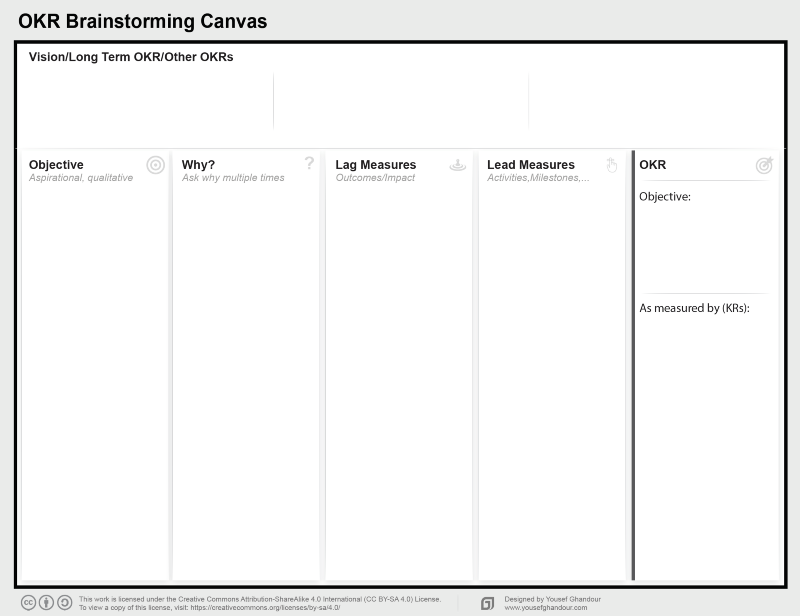
Download OKR Brainstorming Canvas pdf
Long term OKRs, the top section of the OKRs Brainstorming Canvas
I’d like to have the long term OKR visible and accessible while constructing the OKRs for the next cycle (cycle=quarter in my case). It is an optional step, but I’d recommend keeping everyone connected to the long term OKRs while working on the short term ones.
If you don’t have a long term OKR, start with a blank canvas and try constructing one. There is the OKRs Journey Compass too to help you visualize and brainstorm the path from where you are right now to where you want to be.
You can use this section to show another OKR that you need to contribute to, say, for example, the company OKR.
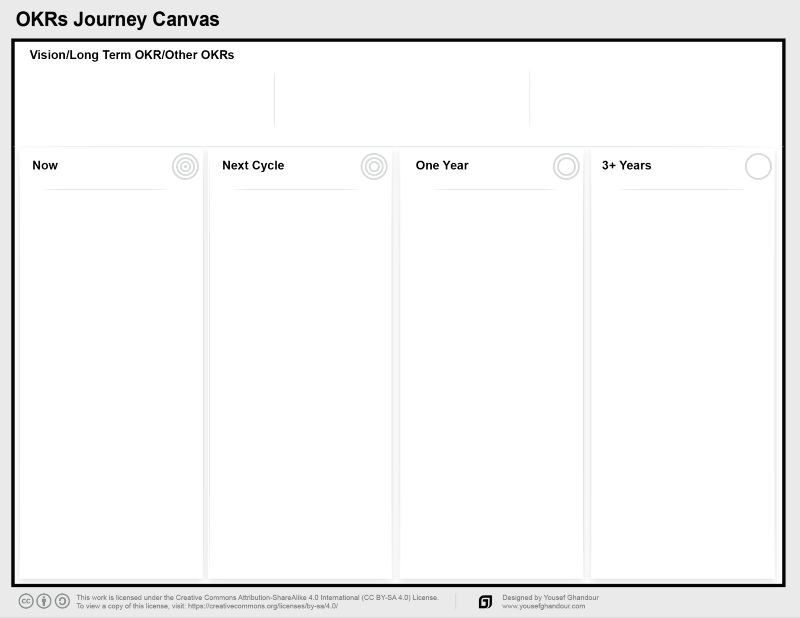
Download OKR Brainstorming Canvas pdf here
What is the OKRs Brainstorming Session
It is a working session where you work with your peers, manager, and sometimes the CEO to brainstorm all the things that might affect your goals. By involving the right people, you will get the following:
- Alignment: High level of alignment since everyone contributed to the process and know how you came up with your OKR
- Creativity: More ideas might lead to better solution and KRs
- Buy-in: collaborators will have skin in the game. Also, even if you don’t go with their ideas, they will feel that they are heard and will understand the logic of why you went with other ideas.
Who to invite to the brainstorming session
Keep the session small, 5–7 people max if possible. I usually involve a product manager, a dev manager, UX designer, and a few stakeholders, and sometimes I invite our CEO.
Sometimes you might need to invite the CEO or your manager to gain alignment and to get them involved in the process, depending on the size and culture of your organization.
How to use the OKRs Brainstorming Canvas
An important thing to remember while using the OKR Brainstorming Canvas is that each column might affect the other columns. It is recommended to use sticky notes or a whiteboard when using the canvas so you can move stickies around.
Objective column
You will start in the objective column, don’t worry if it is not well-worded at this point. You might add a few objectives there and then refine them as you go through the brainstorming session.
Brainstorm objectives for the next cycle. Remember your long term OKRs and how you can make progress toward them. Ask yourself, what will move the needle this cycle? What’s the one thing that if you do, will get you closer to the long term OKRs? Once you have a list of objectives, prioritize them from highest to lowest. Pick one that is the highest priority. Don’t worry, you can always come back and change it.
The “Why?” column
There are two types of “Whys” that could be answered here.
- The “Why” is this important, which connects the objective to the vision and/or long term strategy.
- “Why” to construct the right objective, asking why multiple times to get to the root of what you are trying to achieve or deliver. For example, Objective: Build a new mobile app, Why? To demo it to the board of directors, Why? To get support for the new initiatives. Your Objective could be: Gain support for the new initiatives.
The why is important for a few reasons:
- It provides context to why this objective is important
- It will influence some of the outcomes or lag measures you desire
- It will motivate you and your team members to do what it takes to get it done.
- You can use this section to refine your objective
I sometimes use a “3whys tree” to ask why this value proposition is important. In many situations, I conclude that the problem we are trying to solve, or value we are trying to create is not so obvious.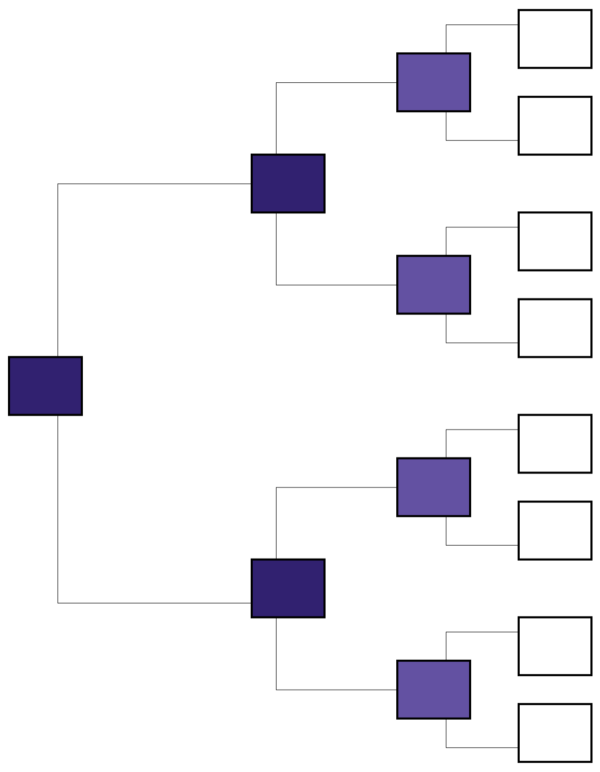
3Whys is a 3 levels of asking why to uncover not so obvious solutions. For example, asking why in this structure will help you get to the root cause of a pain point, understand why a certain solution is important and what does it solve or in the RCA situation, what caused the problem. I like it more than the 5 whys (Lean Manufacturing) in that it is not linear and will help you and your team take multiple routes to get to your answer.
The “why?” will also help you differentiate between the activities you do and the value you create. For example, writing a help document is not the value you create; it is the activity you do to create the desired value: such as helping customers resolve issues faster.
You can use the why column however you like. If it is a feature, you might want to add why this is important. If it is a revenue goal, you might want to add what this will mean to the team, company, customers, etc.
Key Results (Lag measures and Lead measures columns)
Two types of KRs, Lead and Lag Measures
It is very important to distinguish between lead and lag measures. Both are valid KRs (key results), but having the right balance between the two when you construct your KRs is critical.
The easiest way to demonstrate the difference is by using the famous example of losing weight and getting in shape. Objective: Welcome the summer with a beach-ready body. This objective will require losing weight, and toning the muscles, etc. For the sake of this example, let’s assume that you want to lose 10 pounds, and to gain some muscles to tone your body. Here are some of the measures he/she can use:
- Lose 10 pounds of fat
- Gain % of muscle mass
Both of those measures are lag measures since you can’t tell if you achieved them until after the fact, they are lagging indicators that you achieved your goal.
Lead measures, on the other hand, are something you control and have direct influence over. Here are some lead measures for our Objective: Welcome the summer with a beach-ready body:
- Go to the GYM three times a week
- Eat healthy 4 times a week
- Reduce calorie intake by 50%
KRs could be a mix of the two, lead and lag measures, together, if achieved, can get you the summer body that is ready for the beach. KRs could be only lag measures or even lead measures. Personally, I’d like to balance the two. It is like mixing both an outcome and a strategy on how to get to the outcome in a very clear OKR that inspires people and makes the path to success visible.
Be careful when using lead measures in your KRs, it is easy to end up with a todo list OKR.
Lag Measures (Outcomes/Impact)
Looking at the objective, the long term OKR and the why, what are the lag measures that will determine the success or failure of your objective? List all of them first. Make sure you add a specific number when needed. By delivering this objective, what are the outcomes you are expecting to get? Is it customer satisfaction? Increase in revenue? Please note that the outcomes could overlap with the lag measures.
- List all lag measures you can think of
- Use the objective and the “Why” columns to inspire you and to provide more context
- Make sure you add numbers to the lag measures, such as a $ amount, a number of users, etc. For example, how many monthly active users do I need to be able to achieve the objective? Remember, the lag measures provide a means on how to track progress toward your objective.
- If needed, you can update the “Why” and/or the “Objective” columns to match your lag measures new findings.
Lead Measures (Activities)
Brainstorm a list of tactics that you can do to achieve:
- Your objective
- Your lag measures or some of them
Lead measures are under your control. A lead measure could be: call 40 clients this week, it is measurable, under your control, time-bound, and you can easily tell during execution if you are on track or behind.
Lead Measures Vs. Lag Measures
- Tactics are what you do, lag measures are the outcomes
- You can measure tactics during the cycle. Most of the time you would have to wait to collect lag measures: sales results, marketing campaign reach, etc.
- You control your tactics, but you don’t control the outcomes
For the lead measures column, list all of the tactics that you can think of, be creative and try to think outside the box. Once you are done, decide which tactics + lag measures/outcomes/impact will ensure achieving the objective.
- What are the top 2–3 tactics that I can do that can ensure achieving the lag measures and the objective
- Review the lag measures and evaluate which combination of tactics and lag measures make more sense.
Type of Key Results
Here are some common types of numbered values for KRs:
- Currency: For example, increase revenue by $10M | Start: $14M Target: $24M
- Number: Make 100 calls to potential customers | Start: 0 Target: 100
- Yes/No: This is a tricky one, for example, Release Product X. It is either you release the product or you don’t. Alternately to using yes/no Key Results type, you can use percentage to show progress. See the next example.
- Percentage: Percentage is useful if the KR is associated with a big project. For example, Finish development of feature X. You might finish 95% of the feature. Using % in this scenario is better than using yes/no KR value.
OKRs Column
This is where you structure your OKR based on the other columns.
- Write down the objective from the first column. Maybe adjust the wording to match what you want to achieve. Your objective should be directional and inspirational. Remember that your objective is not a goal, the objective and key results are, so your objective doesn’t have to be measurable or specific.
- Add one or more lag measures/outcomes/impact from the lag measures/outcomes/impact columns. For the most part, those lag measures will determine when you will achieve the objective.
- Add a few tactics from your list of tactics/todos that you believe that by doing them, you are most likely to achieve the objective. Please note that sometimes the objective is totally under your control and the tactics/todos will determine the completion of the objective it. For example, if your objective is a bit tactical like Release Product X to the market, then doing all of your tactics/todos will determine the success or failure of the goal. In this case, of course, you probably will not have lag measures.
To summarize, the objective should be directional and inspirational. Add up to five key results to each objective, no more. You Key Results will be a mix between lag measures/outcomes/impact and tactics, most of the time.
Grading and Self-assessment
Grading is the process of scoring your OKRs. Sometimes you need time after the cycle to collect information, such as NPS (Net Promoter Score), revenue, etc.
Don’t confuse grading with the progress you made, sometimes I grade myself at 7.0 even if I hit 100% of the goal. People grade themselves differently, some grade themselves harshly, while others may need to be challenged. Either way, I always try to calibrate with my team members. That said, I’d recommend a clear way to evaluate KRs for new adopters to reduce confusion.
Note: Don’t use OKRs to evaluate people. If you do, people tend to do two things:
- Sandbag themselves by setting achievable goals
- themselves high enough to get a better evaluation, you want your people to always challenge themselves.
For grading, I like Google’s grading scale of 0–1.0, here is an example:
Objective: Expand and improve the product team as measured by (KRs):
- Finish the new, modified interview process by 6/3
- Finish and share the onboarding process by 7/7
- Hire 5 new project managers by 7/20
- Get 20 potential PMs to an onsite interview
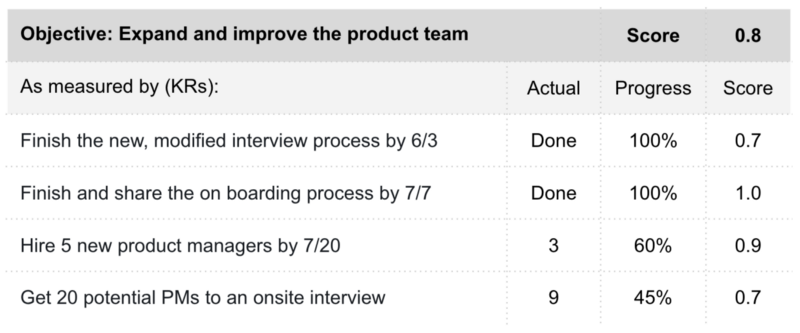
Please note that I gave “Hire 5 new product managers by 7/20” a 0.9 score to demonstrate that sometimes the score is different than the actual % complete. In this case, one of the PMs was a senior PM with great experience in the market, so I gave us a 0.9 out of 1.0 because we hit it out of the park. Another example is “Finish the new, modified interview process by 6/3”. While we got that done, I gave us a 0.7 because I believe we could’ve done a better job. For this example, the score of the overall OKRs is the average of the KRs scores: 0.8.
Reflection
Adding reflection to the grading table is helpful and will encourage people to do things differently to get better.

OKRs, as with any other framework, can be tricky. OKRs are action-oriented, and can easily get you trapped in a circle which will cause frustration and eventually abandonment of OKRs. With OKRs, you can set aggressive goals, achieve most of them, pause to reflect on achievements, then repeat.
“We do not learn from experience . . . we learn from reflecting on experience.”~John Dewey
Questions to consider when closing an OKR cycle
- Did I accomplish all of my objectives?
- Highlights: What contributed to my success?
- Lowlights: What obstacles did I encounter?
- Where the outcomes achieved? If I were to rewrite an objective I achieved in full, what would I change?
Resources
- https://www.yousefghandour.com/okrs-brainstorming-canvas by Yousef Ghandour
